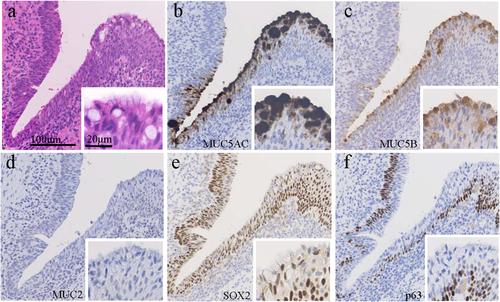下载PDF
{"title":"A Comparative Immunohistochemical Study of Anal Canal Epithelium in Humans and Swine, Focusing on the Anal Transitional Zone Epithelium and the Anal Glands","authors":"Futoshi Muranaka, Tomoyuki Nakajima, Mai Iwaya, Keiko Ishii, Kayoko Higuchi, Naoko Ogiwara, Shinichi Miyagawa, Hiroyoshi Ota","doi":"10.1002/ar.23748","DOIUrl":null,"url":null,"abstract":"<div>\n \n <p>To better understand the cellular origins and differentiation of anal canal epithelial neoplasms, the immunohistochemical profiles of the anal canal epithelium in humans and swine were evaluated. Formalin-fixed tissue sections were immunostained for mucin (MUC: MUC2, MUC5AC, MUC5B), desmoglein 3 (DGS3), p63, CDX2, SOX2, and α-smooth muscle actin (α-SMA). The anal transitional zone (ATZ) epithelium covered the anal sinus and consisted of a stratified epithelium with mucous cells interspersed within the surface lining. Anal glands opened into the anal sinus. Ducts and acini of intraepithelial or periepithelial mucous type were the main structures of human anal glands, whereas those of swine were compound tubuloacinar mixed glands. Distal to the ATZ epithelium, non-keratinized stratified squamous epithelium merged with the keratinized stratified squamous epithelium of the perianal skin. MUC5AC expression predominated over MUC5B expression in the ATZ epithelium, while MUC5B expression was higher in the anal glands. SOX2 was positive in the ATZ epithelium, anal glands, and squamous epithelium except in the perianal skin. In humans, DGS3 was expressed in the ATZ epithelium, anal gland ducts, and squamous epithelium. p63 was detected in the ATZ epithelium, anal glands, and squamous epithelium. Myoepithelial cells positive for α-SMA and p63 were present in the anal glands of swine. Colorectal columnar cells were MUC5B<sup>+</sup>/MUC2<sup>+</sup>/CDX2<sup>+</sup>/MUC5AC<sup>−</sup>/SOX2<sup>−</sup>. The ATZ epithelium seems to be a distinctive epithelium, with morphological and functional features allowing smooth defecation. The MUC5AC<sup>+</sup>/SOX2<sup>+</sup>/MUC2<sup>−</sup>/CDX2<sup>−</sup> profile of the ATZ epithelium and anal glands is a useful feature for diagnosing adenocarcinoma arising from these regions. Anat Rec, 301:796–805, 2018. © 2017 Wiley Periodicals, Inc.</p>\n </div>","PeriodicalId":50965,"journal":{"name":"Anatomical Record-Advances in Integrative Anatomy and Evolutionary Biology","volume":"301 5","pages":"796-805"},"PeriodicalIF":1.8000,"publicationDate":"2017-12-12","publicationTypes":"Journal Article","fieldsOfStudy":null,"isOpenAccess":false,"openAccessPdf":"https://sci-hub-pdf.com/10.1002/ar.23748","citationCount":"7","resultStr":null,"platform":"Semanticscholar","paperid":null,"PeriodicalName":"Anatomical Record-Advances in Integrative Anatomy and Evolutionary Biology","FirstCategoryId":"3","ListUrlMain":"https://onlinelibrary.wiley.com/doi/10.1002/ar.23748","RegionNum":4,"RegionCategory":"医学","ArticlePicture":[],"TitleCN":null,"AbstractTextCN":null,"PMCID":null,"EPubDate":"","PubModel":"","JCR":"Q2","JCRName":"ANATOMY & MORPHOLOGY","Score":null,"Total":0}
引用次数: 7
引用
批量引用
Abstract
To better understand the cellular origins and differentiation of anal canal epithelial neoplasms, the immunohistochemical profiles of the anal canal epithelium in humans and swine were evaluated. Formalin-fixed tissue sections were immunostained for mucin (MUC: MUC2, MUC5AC, MUC5B), desmoglein 3 (DGS3), p63, CDX2, SOX2, and α-smooth muscle actin (α-SMA). The anal transitional zone (ATZ) epithelium covered the anal sinus and consisted of a stratified epithelium with mucous cells interspersed within the surface lining. Anal glands opened into the anal sinus. Ducts and acini of intraepithelial or periepithelial mucous type were the main structures of human anal glands, whereas those of swine were compound tubuloacinar mixed glands. Distal to the ATZ epithelium, non-keratinized stratified squamous epithelium merged with the keratinized stratified squamous epithelium of the perianal skin. MUC5AC expression predominated over MUC5B expression in the ATZ epithelium, while MUC5B expression was higher in the anal glands. SOX2 was positive in the ATZ epithelium, anal glands, and squamous epithelium except in the perianal skin. In humans, DGS3 was expressed in the ATZ epithelium, anal gland ducts, and squamous epithelium. p63 was detected in the ATZ epithelium, anal glands, and squamous epithelium. Myoepithelial cells positive for α-SMA and p63 were present in the anal glands of swine. Colorectal columnar cells were MUC5B+ /MUC2+ /CDX2+ /MUC5AC− /SOX2− . The ATZ epithelium seems to be a distinctive epithelium, with morphological and functional features allowing smooth defecation. The MUC5AC+ /SOX2+ /MUC2− /CDX2− profile of the ATZ epithelium and anal glands is a useful feature for diagnosing adenocarcinoma arising from these regions. Anat Rec, 301:796–805, 2018. © 2017 Wiley Periodicals, Inc.
人与猪肛管上皮的免疫组化比较研究,重点是肛门过渡带上皮和肛门腺
为了更好地了解肛管上皮肿瘤的细胞起源和分化,我们对人和猪的肛管上皮进行了免疫组织化学分析。用福尔马林固定组织切片免疫染色检测粘蛋白(mucc: MUC2、MUC5AC、MUC5B)、粘粒蛋白3 (DGS3)、p63、CDX2、SOX2和α-平滑肌肌动蛋白(α-SMA)。肛交区(ATZ)上皮覆盖在肛窦上,由层状上皮组成,粘膜细胞散布在表面衬里。肛门腺进入肛门窦。人肛门腺以上皮内或上皮周围黏液型的管状腺和腺泡为主,猪肛门腺以复合管状腺泡混合腺为主。在ATZ上皮的远端,未角化的层状鳞状上皮与肛周皮肤的角化层状鳞状上皮合并。MUC5AC在ATZ上皮中的表达高于MUC5B,而MUC5B在肛腺中的表达较高。SOX2在除肛周皮肤外的ATZ上皮、肛门腺和鳞状上皮中呈阳性。在人类中,DGS3在ATZ上皮、肛门腺管和鳞状上皮中表达。在ATZ上皮、肛门腺和鳞状上皮中检测到p63。猪肛门腺中存在α-SMA和p63阳性的肌上皮细胞。结直肠柱状细胞MUC5B+/MUC2+/CDX2+/MUC5AC−/SOX2−。ATZ上皮似乎是一种独特的上皮,具有形态和功能特征,允许顺利排便。ATZ上皮和肛门腺的MUC5AC+/SOX2+/MUC2 - /CDX2 -谱是诊断这些区域引起的腺癌的有用特征。中国生物医学工程学报,2018,31(1):796 - 805。©2017 Wiley期刊公司
本文章由计算机程序翻译,如有差异,请以英文原文为准。


